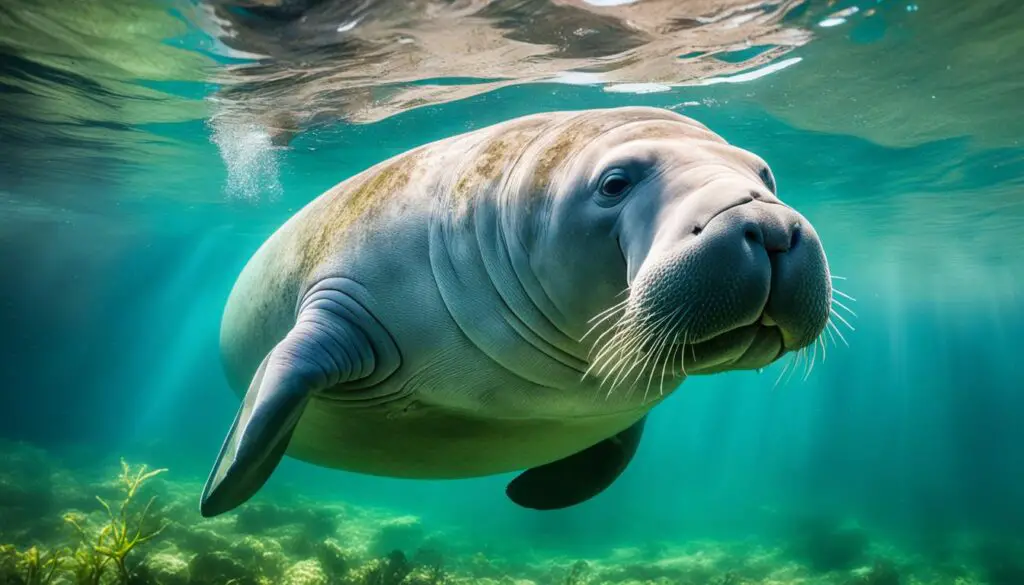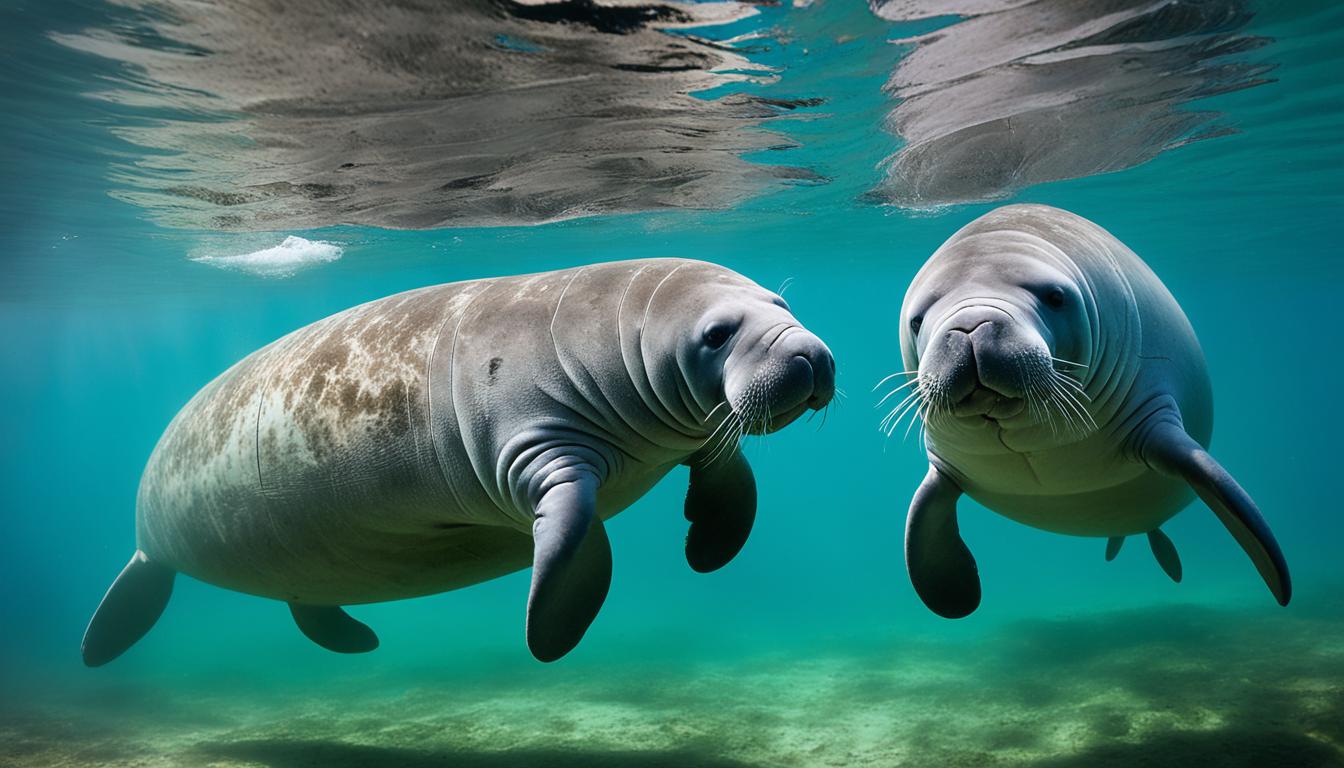Learning about manatee reproduction is key to saving this endangered species. This guide will show you how manatees reproduce and what affects their breeding. You’ll learn about their mating, pregnancy, and caring for their young. Each step is crucial for their survival.
Introduction to Manatee Reproduction
Learning about manatee reproduction helps us understand these amazing creatures. Manatees, also called sea cows, are part of the Sirenia order. Their breeding habits are unique and important for their survival in the water.
The way manatees reproduce is key to keeping their numbers stable. During mating season, they find partners in warm coastal waters. The success of breeding depends on the environment and how much food is available.
Manatees have a long pregnancy, lasting about a year. After the baby is born, the mother and calf form a strong bond. She teaches the calf how to survive in the water. Knowing how manatees reproduce shows why we need to protect their homes.
In short, manatees’ breeding habits and cycles are crucial to their lives. They affect not just individual manatees but the whole population too.
How do manatees reproduce?
Manatees have a unique way of reproducing. It involves looking at their sexual maturity and mating habits. These factors show how their reproductive system works and their special anatomy.
Sexual Maturity of Manatees
Manatees grow up at different ages. Girls usually get ready to have babies around three years old. Boys take about nine years to mature. This difference affects how they mate and reproduce.
Young girls might have a baby soon after they can. This shows they are ready to have a calf.
Breeding Cycles and Mating Behavior
During mating seasons, you might see manatees mating. You’ll often see a group of males following one female. This shows how competitive they are in finding a mate.
This behavior is natural for them. It shows how important competition is in their mating and breeding.
Manatee Breeding Season and Courtship Rituals
The manatee breeding season is a captivating event. It shows off their complex courtship behaviors. These behaviors are key to their reproduction. Manatees can breed all year, but some times are busier than others.
Learning about their courtship rituals helps us understand their mating and social life.
Mating Process in the Water
Manatees have a unique way of mating in the water. Several males gather around a female, making it a competitive scene. They use movements and sounds to show they’re interested.
Each male tries to stand out by showing off his strength and agility. This shows how important being strong and social is in finding a mate.
Role of Males and Competition
Males play a big part in manatee courtship during the breeding season. They need to stay close to the female during her fertile time. This leads to a lot of competition among males.
Big and strong males often get ahead by using their size and endurance. This competition helps ensure the strongest genes are passed on.
Understanding the Gestation Period of Manatees
The reproductive cycle of manatees is quite interesting. It includes the manatee gestation period and how often they give birth. These aspects show us how their behavior is linked to the environment.
Duration of Gestation
Manatees are pregnant for about 13 months. This long time helps the calf grow strong. Most of the time, only one calf is born, but sometimes twins happen.
This long gestation is key for the calf to be ready for life outside the womb.
Calving Frequency and Conditions Affecting It
Healthy female manatees usually have a calf every two to five years. Many things can change how often they have babies. Things like food, water quality, and where they live are very important.
If these things are bad, it might make it harder for a female to have a baby. This can affect how many manatees there are.

| Factor | Impact on Reproduction |
|---|---|
| Food Habitat Quality | Affects energy levels for reproduction and calf raising |
| Environmental Stressors | Harsh conditions can lead to longer intervals between births |
| Water Temperature | Optimal temperatures are necessary for calf survival |
| Human Activity | Can disrupt natural habitats and affect reproduction rates |
Manatee Reproductive Anatomy Explained
The reproductive anatomy of manatees is quite interesting. It helps tell males from females. It’s key for researchers and fans to know about these features.
One key feature in manatee anatomy is where their genital openings are. Males have theirs behind the belly button. Females have theirs just before the anus. This helps tell males from females.
- Male Manatee: Genital opening found behind the navel.
- Female Manatee: Genital opening located just before the anus.
It’s hard to tell a manatee’s sex just by looking at it. They don’t have big differences in their looks. So, knowing about their reproductive anatomy is very important.
By understanding the differences in reproductive anatomy, researchers can learn a lot. They can study the population and health of these amazing sea creatures.
Breeding Habits and Calf Care
The bond between mother manatees and their calves is key to their early growth. This bond helps the young ones survive. It’s both emotional and practical, giving the calf vital nutrients for about a year or two.
Mother-Calf Bonding and Nursing
Mother-calf bonding in manatees means being close and making sounds. Mothers teach their young important things like finding food and moving safely. This bond helps the calf grow emotionally and physically.
Survival Challenges for Young Manatees
Young manatees have many challenges despite their strong bond with their mothers. Crocodiles are a threat, but humans are a bigger danger. Boats and fishing gear often harm or kill them. Knowing these dangers helps us protect these amazing animals.
| Survival Challenges | Description | Impact on Young Manatees |
|---|---|---|
| Natural Predators | Crocodiles and large fish | Risk of injury or death |
| Boat Strikes | Collisions with motorboats | Severe injuries or fatalities |
| Fishing Gear Entanglement | Getting caught in nets or lines | Limit mobility and lead to drowning |
The Impact of Environment on Manatee Reproduction
Looking into the manatee’s world, we see many things affect their ability to reproduce. Clean water, a safe place to live, and enough food are key. Pollution can make the water unhealthy, making it hard for manatees to mate and carry their young.
Also, losing their homes to cities and climate change can mess up where manatees live. This stress can lead to fewer baby manatees and could even cause their numbers to go down. Seagrasses are a main food for manatees, so having enough of them is crucial for their survival and breeding.
It’s important to know how changes in the environment affect manatees. By protecting their homes and keeping the water clean, we can help manatees have a better chance to breed and stay healthy. This is key to keeping these amazing animals and their role in the ocean safe for the future.










